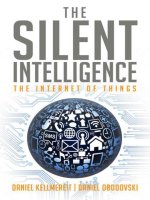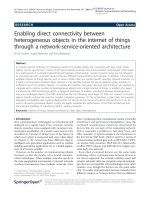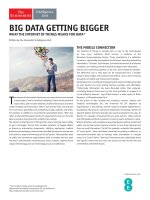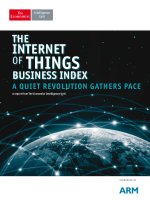Analyzing data in the internet of things
Bạn đang xem bản rút gọn của tài liệu. Xem và tải ngay bản đầy đủ của tài liệu tại đây (2.11 MB, 86 trang )
Strata + Hadoop
Analyzing Data in the Internet of
Things
A Collection of Talks from Strata + Hadoop World 2015
Alice LaPlante
Analyzing Data in the Internet of Things
by Alice LaPlante
Copyright © 2016 O’Reilly Media, Inc. All rights reserved.
Printed in the United States of America.
Published by O’Reilly Media, Inc., 1005 Gravenstein Highway North,
Sebastopol, CA 95472.
O’Reilly books may be purchased for educational, business, or sales
promotional use. Online editions are also available for most titles
(). For more information, contact our
corporate/institutional sales department: 800-998-9938 or
Editor: Shannon Cutt
Production Editor: Shiny Kalapurakkel
Copyeditor: Jasmine Kwityn
Proofreader: Susan Moritz
Interior Designer: David Futato
Cover Designer: Randy Comer
May 2016: First Edition
Revision History for the First Edition
2016-05-13: First Release
The O’Reilly logo is a registered trademark of O’Reilly Media, Inc.
Analyzing Data in the Internet of Things, the cover image, and related trade
dress are trademarks of O’Reilly Media, Inc.
While the publisher and the author have used good faith efforts to ensure that
the information and instructions contained in this work are accurate, the
publisher and the author disclaim all responsibility for errors or omissions,
including without limitation responsibility for damages resulting from the use
of or reliance on this work. Use of the information and instructions contained
in this work is at your own risk. If any code samples or other technology this
work contains or describes is subject to open source licenses or the
intellectual property rights of others, it is your responsibility to ensure that
your use thereof complies with such licenses and/or rights.
978-1-491-95901-5
[LSI]
Introduction
Alice LaPlante
The Internet of Things (IoT) is growing quickly. More than 28 billion things
will be connected to the Internet by 2020, according to the International Data
Corporation (IDC).1 Consider that over the last 10 years:2
The cost of sensors has gone from $1.30 to $0.60 per unit.
The cost of bandwidth has declined by 40 times.
The cost of processing has declined by 60 times.
Interest as well as revenues has grown in everything from smartwatches and
other wearables, to smart cities, smart homes, and smart cars. Let’s take a
closer look:
Smart wearables
According to IDC, vendors shipped 45.6 million units of wearables in
2015, up more than 133% from 2014. By 2019, IDC forecasts annual
shipment volumes of 126.1 million units, resulting in a five-year
compound annual growth rate (CAGR) of 45.1%.3 This is fueling
streams of big data for healthcare research and development — both in
academia and in commercial markets.
Smart cities
With more than 60% of the world’s population expected to live in urban
cities by 2025, we will be seeing rapid expansion of city borders, driven
by population increases and infrastructure development. By 2023, there
will be 30 mega cities globally.4 This in turn will require an emphasis on
smart cities: sustainable, connected, low-carbon cities putting initiatives
in place to be more livable, competitive, and attractive to investors. The
market will continue growing to $1.5 trillion by 2020 through such
diverse areas as transportation, buildings, infrastructure, energy, and
security.5
Smart homes
Connected home devices will ship at a compound annual rate of more
than 67% over the next five years, and will reach 1.8 billion units by
2019, according to BI Intelligence. Such devices include smart
refrigerators, washers, and dryers, security systems, and energy
equipment like smart meters and smart lighting.6 By 2019, it will
represent approximately 27% of total IoT product shipments.7
Smart cars
Self-driving cars, also known as autonomous vehicles (AVs), have the
potential to disrupt a number of industries. Although the exact timing of
technology maturity and sales is unclear, AVs could eventually play a
“profound” role in the global economy, according to McKinsey & Co.
Among other advantages, AVs could reduce the incidence of car
accidents by up to 90%, saving billions of dollars annually.8
In this O’Reilly report, we explore the IoT industry through a variety of
lenses, by presenting you with highlights from the 2015 Strata + Hadoop
World Conferences that took place in both the United States and Singapore.
This report explores IoT-related topics through a series of case studies
presented at the conferences. Topics we’ll cover include modeling machine
failure in the IoT, the computational gap between CPU storage, networks on
the IoT, and how to model data for the smart connected city of the future.
Case studies include:
Spark Streaming to predict failure in railway equipment
Traffic monitoring in Singapore through the use of a new IoT app
Applications from the smart city pilot in Oulu, Finland
An ongoing longitudinal study using personal health data to reduce
cardiovascular disease
Data analytics being used to reduce risk in human space missions under
NASA’s Orion program
We finish with a discussion of ethics, related to the algorithms that control
the things in the Internet of Things. We’ll explore decisions related to data
from the IoT, and opportunities to influence the moral implications involved
in using the IoT.
1
Goldman Sachs, “Global Investment Research,” September 2014.
2
Ibid.
3
IDC, “Worldwide Quarterly Device Tracker,” 2015.
4
Frost & Sullivan. “Urbanization Trends in 2020: Mega Cities and Smart Cities Built on a Vision of
Sustainability,” 2015.
5
World Financial Symposiums, “Smart Cities: M&A Opportunities,” 2015.
6
BI Intelligence. The Connected Home Report. 2014.
7
Ibid.
8
Michelle Bertoncello and Dominik Wee (McKinsey & Co.). Ten Ways Autonomous Driving Could
Reshape the Automotive World. June 2015.
Part I. Data Processing and
Architecture for the IoT
Chapter 1. Data Acquisition and
Machine-Learning Models
Danielle Dean
Editor’s Note: At Strata + Hadoop World in Singapore, in December 2015,
Danielle Dean (Senior Data Scientist Lead at Microsoft) presented a talk
focused on the landscape and challenges of predictive maintenance
applications. In her talk, she concentrated on the importance of data
acquisition in creating effective predictive maintenance applications. She
also discussed how to formulate a predictive maintenance problem into three
different machine-learning models.
Modeling Machine Failure
The term predictive maintenance has been around for a long time and could
mean many different things. You could think of predictive maintenance as
predicting when you need an oil change in your car, for example — this is a
case where you go every six months, or every certain amount of miles before
taking your car in for maintenance.
But that is not very predictive, as you’re only using two variables: how much
time has elapsed, or how much mileage you’ve accumulated. With the IoT
and streaming data, and with all of the new data we have available, we have a
lot more information we can leverage to make better decisions, and many
more variables to consider when predicting maintenance. We also have many
more opportunities in terms of what you can actually predict. For example,
with all the data available today, you can predict not just when you need an
oil change, but when your brakes or transmission will fail.
Root Cause Analysis
We can even go beyond just predicting when something will fail, to also
predicting why it will fail. So predictive maintenance includes root cause
analysis.
In aerospace, for example, airline companies as well as airline engine
manufacturers can predict the likelihood of flight delay due to mechanical
issues. This is something everyone can relate to: sitting in an airport because
of mechanical problems is a very frustrating experience for customers — and
is easily avoided with the IoT.
You can do this on the component level, too — asking, for example, when a
particular aircraft component is likely to fail next.
Application Across Industries
Predictive maintenance has applications throughout a number of industries.
In the utility industry, when is my solar panel or wind turbine going to fail?
How about the circuit breakers in my network? And, of course, all the
machines in consumers’ daily lives. Is my local ATM going to dispense the
next five bills correctly, or is it going to malfunction? What maintenance
tasks should I perform on my elevator? And when the elevator breaks, what
should I do to fix it?
Manufacturing is another obvious use case. It has a huge need for predictive
maintenance. For example, doing predictive maintenance at the component
level to ensure that it passes all the safety checks is essential. You don’t want
to assemble a product only to find out at the very end that something down
the line went wrong. If you can be predictive and rework things as they come
along, that would be really helpful.
A Demonstration: Microsoft Cortana Analytics Suite
We used the Cortana Analytics Suite to solve a real-world predictive
maintenance problem. It helps you go from data, to intelligence, to actually
acting upon it.
The Power BI dashboard, for example, is a visualization tool that enables you
to see your data. For example, you could look at a scenario to predict which
aircraft engines are likely to fail soon. The dashboard might show
information of interest to a flight controller, such as how many flights are
arriving during a certain period, how many aircrafts are sending data, and the
average sensor values coming in.
The dashboard may also contain insights that can help you answer questions
like “Can we predict the remaining useful life of the different aircraft
engines?”or “How many more flights will the engines be able to withstand
before they start failing?” These types of questions are where the machine
learning comes in.
Data Needed to Model Machine Failure
In our flight example, how does all of that data come together to make a
visually attractive dashboard?
Let’s imagine a guy named Kyle. He maintains a team that manages aircrafts.
He wants to make sure that all these aircrafts are running properly, to
eliminate flight delays due to mechanical issues.
Unfortunately, airplane engines often show signs of wear, and they all need
to be proactively maintained. What’s the best way to optimize Kyle’s
resources? He wants to maintain engines before they start failing. But at the
same time, he doesn’t want to maintain things if he doesn’t have to.
So he does three different things:
He looks over the historical information: how long did engines run in
the past?
He looks at the present information: which engines are showing signs of
failure today?
He looks to the future: he wants to use analytics and machine learning to
say which engines are likely to fail.
Training a Machine-Learning Model
We took publicly available data that NASA publishes on engine run-tofailure data from aircraft, and we trained a machine-learning model. Using
the dataset, we built a model that looks at the relationship between all of the
sensor values, and whether an engine is going to fail. We built that machinelearning model, and then we used Azure ML Studio to turn it into an API. As
a standard web service, we can then integrate it into a production system that
calls out on a regular schedule to get new predictions every 15 minutes, and
we can put that data back into the visualization.
To simulate what would happen in the real world, we take the NASA data,
and use a data generator that sends the data in real time, to the cloud. This
means that every second, new data is coming in from the aircrafts, and all of
the different sensor values, as the aircrafts are running. We now need to
process that data, but we don’t want to use every single little sensor value that
comes in every second, or even subsecond. In this case, we don’t need that
level of information to get good insights. What we need to do is create some
aggregations on the data, and then use the aggregations to call out to the
machine-learning model.
To do that, let’s look at numbers like the average sensor values, or the rolling
standard deviation; we want to then predict how many cycles are left. We
ingest that data through Azure Event Hub and use Azure Stream Analytics,
which lets you do simple SQL queries on that real-time data. You can then do
things like select the average over the last two seconds, and output that to
Power BI. We then do some SQL-like real-time queries in order to get
insights, and show that right to Power BI.
We then take the aggregated data and execute a second batch, which uses
Azure Data Factory to create a pipeline of services. In this example, we’re
scheduling an aggregation of the data to a flight level, calling out to the
machine-learning API, and putting the results back in SQL database so we
can visualize them. So we have information about the aircrafts and the flights,
and then we have lots of different sensor information about it, and this
training data is actually run-to-failure data, meaning we have data points until
the engine actually fails.
Getting Started with Predictive Maintenance
You might be thinking, “This sounds great, but how do I know if I’m ready to
do machine learning?” Here are five things to consider before you begin
doing predictive maintenance:
What kind of data do you need?
First, you must have a very “sharp” question. You might say, “We have
a lot of data. Can we just feed the data in and get insights out?” And
while you can do lots of cool things with visualization tools and
dashboards, to really build a useful and impactful machine-learning
model, you must have that question first. You need to ask something
specific like: “I want to know whether this component will fail in the
next X days.”
You must have data that measures what you care about
This sounds obvious, but at the same time, this is often not the case. If
you want to predict things such as failure at the component level, then
you have to have component-level information. If you want to predict a
door failure within a car, you need door-level sensors. It’s essential to
measure the data that you care about.
You must have accurate data
It’s very common in predictive maintenance that you want to predict a
failure occurring, but what you’re actually predicting in your data is not
a real failure. For example, predicting fault. If you have faults in your
dataset, those might sometimes be failures, but sometimes not. So you
have to think carefully about what you’re modeling, and make sure that
that is what you want to model. Sometimes modeling a proxy of failure
works. But if sometimes the faults are failures, and sometimes they
aren’t, then you have to think carefully about that.
You must have connected data
If you have lots of usage information — say maintenance logs — but
you don’t have identifiers that can connect those different datasets
together, that’s not nearly as useful.
You must have enough data
In predictive maintenance in particular, if you’re modeling machine
failure, you must have enough examples of those machines failing, to be
able to do this. Common sense will tell you that if you only have a
couple of examples of things failing, you’re not going to learn very well;
having enough raw examples is essential.
Feature Engineering Is Key
Feature engineering is where you create extra features that you can bring into
a model. In our example using NASA data, we don’t want to just use that raw
information, or aggregated information — we actually want to create extra
features, such as change from the initial value, velocity of change, and
frequency count. We do this because we don’t want to know simply what the
sensor values are at a certain point in time — we want to look back in the
past, and look at features. In this case, any kinds of features that can capture
degradation over time are very important to include in the model.
Three Different Modeling Techniques
You’ve got a number of modeling techniques you can choose from. Here are
three we recommend:
Binary classification
Use binary classification if you want to do things like predict whether a
failure will occur in a certain period of time. For example, will a failure
occur in the next 30 days or not?
Multi-class classification
This is for when you want to predict buckets. So you’re asking if an
engine will fail in the next 30 days, next 15 days, and so forth.
Anomaly detection
This can be useful if you actually don’t have failures. You can do things
like smart thresholding. For example, say that a door’s closing time goes
above a certain threshold. You want an alert to tell you that something’s
changed, and you also want the model to learn what the new threshold is
for that indicator.
These are relatively simplistic, but effective techniques.
Start Collecting the Right Data
A lot of IoT data is not used currently. The data that is used is mostly for
anomaly detection and control, not prediction, which is what can provide us
with the greatest value. So it’s important to think about what you will want to
do in the future. It’s important to collect good quality data over a long enough
period of time to enable your predictive analytics in the future. The analytics
that you’re going to be doing in two or five years is going to be using today’s
data.
Chapter 2. IoT Sensor Devices
and Generating Predictions
Bruno Fernandez-Ruiz
Editor’s Note: At Strata + Hadoop World in San Jose, in February 2015,
Bruno Fernandez-Ruiz (Senior Fellow at Yahoo!) presented a talk that
explores two issues that arise due to the computational resource gap between
CPUs, storage, and network on IoT sensor devices: (a ) undefined prediction
quality, and (b ) latency in generating predictions.
Let’s begin by defining the resource gap we face in the IoT by talking about
wearables and the data they provide. Take, for example, an optical heart rate
monitor in the form of a GPS watch. These watches measure the conductivity
of the photocurrent, through the skin, and infer your actual heart rate, based
on that data.
Essentially, it’s an input and output device, that goes through some “black
box” inside the device. Other devices are more complicated. One example is
Mobileye, which is a combination of radar/lidar cameras embedded in a car
that, in theory, detects pedestrians in your path, and then initiates a braking
maneuver. Tesla is going to start shipping vehicles with this device.
Likewise, Mercedes has an on-board device called Sonic Cruise, which is
essentially a lidar (similar to a Google self-driving car). It sends a beam of
light, and measures the reflection that comes back. It will tell you the distance
between your car and the next vehicle, to initiate a forward collision warning
or even a maneuver to stop the car.
In each of these examples, the device follows the same pattern — collecting
metrics from a number of data sources, and translating those signals into
actionable information. Our objective in such cases is to find the best
function that minimizes the minimization error.
To help understand minimization error, let’s go back to our first example —
measuring heart rate. Consider first that there is an actual value for your real
heart rate, which can be determined through an EKG. If you use a wearable to
calculate the inferred value of your heart rate, over a period of time, and then
you sum the samples, and compare them to the EKG, you can measure the
difference between them, and minimize the minimization error.
What’s the problem with this?









